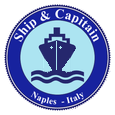 |

|
 |
 |
|
Nave
da passeggeri
| ||
|
FLAVIA C.
|
| Bandiera | Flag | Italiana - Italian | |||||||||
| Armatore | Owner | Costa Crociere - Genova - Italy | |||||||||
| Varo | Launched | 12.12.1946 - ristrutturata/rebuilt 1961 | |||||||||
| Consegnata | Delivered | 08.1947 | |||||||||
| Cantiere navale | Shipyard | John Brown & Co - Clydebank - United Kingdom | |||||||||
| Costruzione n. | Yard number | 629 | |||||||||
| Tipo di scafo | Hull type | doppio scafo - double hull | |||||||||
| Materiale dello scafo | Hull material | acciaio - steel | |||||||||
| Nominativo Internazionale | Call Sign | I B W
Q - |
|||||||||
| I.M.O. Internationa Maritime Organization | 5116139 | ||||||||||
| M.M.S.I. Maritime Mobile System Identify | |||||||||||
| Compartimento Marittimo | Port of Registry | Genova | |||||||||
| Numero di Registro | Official Number | 1069 | |||||||||
| Posizione attuale | Actual position | ||||||||||
| Stazza Lorda | Gross Tonnage | 13.345 Tons > 15.456 Tons | |||||||||
| Stazza Netta | Net Tonnage | ||||||||||
| Portata (estiva) | DWT (summer) | 6.903 | |||||||||
| Lunghezza max | L.o.a. | 161,85 m > 169,77 m | |||||||||
| Lunghezza tra le Pp | L. between Pp | 152,4 m | |||||||||
| Larghezza max | Breadth max | 21,34 m | |||||||||
| Altezza di costruzione | Depth | ||||||||||
| Pescaggio Max | Draugth max | 7,92 m | |||||||||
| Bordo libero | Freeboard | ||||||||||
| Motore principale | Main Engine | 2 - Turbine a vapore/steam turbines John Brown & co | |||||||||
| Potenza Motori | Engine Power | 11.000 Kw | |||||||||
| Eliche di propulsione | Propellers | 2 - passo fisso / fixed pitch | |||||||||
| Velocità massima | Max speed | 18,0 kn | |||||||||
| Ponti | Decks | ||||||||||
| Passeggeri | Passengers | 1.320 | |||||||||
| Equipaggio | Crew | ||||||||||
| Acqua di zavorra | Ballast water | ||||||||||
| Volume di carico merci | Cargo capacity | ||||||||||
| Demolita | Scrapped |
Kaohsiung
19.06.1989 (Chi Shun Hia acciaio Co Ltd)
|
|||||||||
| Inserita il | Posted |
26.04.2014
|
|||||||||
| Aggiornata al | Last updated |
26.09.2016
|
|||||||||
La
T/N FLAVIA fu acquistata dalla Cunard nel 1961 da parte della
"Cogedar" (acronimo di "COmpagnia GEnovese Di ARmamento"),
societa` di navigazione che nulla aveva all'epoca a che fare con la
"Giacomo Costa fu Andrea" ovvero
"Line" C "," as was advertised commercially. The ship, ex- "MEDIA" of Cunard, was in fact bought by Cogedar to be used in the service of online tourist class Europe-Australia paired with the M / V "AURELIA" (ex-HUASCARAN) in place of M / N FLAMINIA (ex-GENOA) now totally obsolete. The "FLAVIA" was essentially used to transport emigrants between Northern Europe (Bremerhaven) and Australia via Suez, sometimes (but not always) with a stopover in Naples, while the return trip was a trip along a route called " tourism "which included the> Pacific voyage with stopovers in Auckland (New Zealand) and Papeete (French Polynesia), the passage of the Panama canal (direct flights to Balboa), a stop in Curacao (Netherlands Antilles) to return to Bremerhaven via Southampton and Rotterdam. While the outward journey was attended mainly by emigrants who abandoned definitively 'Europe, the return was frequented by migrants living in Australia and also in the West Indies who were returning to Europe in tourist trips, Especially to Britain, but on average no remain. The ship remained on this service, which in effect was a> service line and not cruising, until the closure of the Suez Canal in 1967 when the two ships, and FLAVIA AURELIA, were made to pass through Cape City. For an identical service and with quite similar events were engaged vessels SITMAR (FAIRSEA, CASTEL HAPPY and Fairsky, which in 1964 was added the Fairstar former OXFORDSHIRE). Services of Cogedar, either by changes in transport contracts of migrants, either by the closure of the Suez Canal, they were suspended in 1968 and FLAVIA, after the last cruise departing from 'Australia, September 20, 1968 lascio` Melbourne live in Europe. During his return trip was chartered to "Atlantic Cruise Line" for cruises from Miami and towards the end of the year sold to the Coast where the ship was not before never belonged. On this occasion the crews of Cogedar were partly transferred to the Coast and in part to SITMAR and since then the comincio` new story of "FLAVIA" under the colors of the Coast. After the purchase by the Shipowners Costa underwent renovations and transformation at the Officine A & R Navi Genoa and became a cruise ship. Was lengthened by 7,92 m this involved the increase in tonnage of 13,345 GRT to 15,465 GRT. Could carry 1,320 passengers in economy class. The ship was renamed FLAVIA C and used for cruises in the world.In 1982 he was sold to the Shipping Company of Hong Kong and renamed FLAVIO to be used as a casino cruise ship but these cruises were unpopular and FLAVIO spent most of the time moored in the port of Hong Kong. In 1986 it was renamed LAVIA for Lavia Shipping of Panma, January 7, 1989, during some works burst a fire which quickly spread throughout the ship, fortunately there were no deaths. four fireboats and more than 250 firefighters were deployed to extinguish the fire but LAVIA sank due to the large amount of water pumped aboard in an attempt to extinguish the flames. The ship was refloated and towed to Taiwan, where he arrived on June 19. It was demolished by Chi Shun Hia Steel Co Ltd, Kaohsiung. THIS HISTORICAL INFORMATION ARE UPDATED THANKS TO THE INFORMATION SIG.MARIO SANNINO
|
|||||||||||